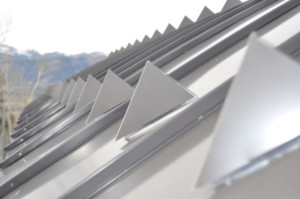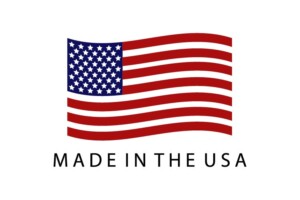Because every roofing project is different, it is impossible to say how many snow guards you will need. Many factors affect the number of snow guards needed on a roof including rafter length, snow load, roof slope, and the type of snow guard used. Give us a call and we will be glad to provide you with a free customized layout and estimate for your specific project.
No. Galvanic corrosion (sometimes called rust) occurs when two dissimilar metals are brought into contact in the presence of an electrolyte (moisture). Simply put, when a snow stop made of a certain type of metal is placed on a roof made of a different type of metal and is exposed to snow, rain, and ice, they begin to corrode. This process is called galvanic corrosion and is the cause of the staining and streaking of the roof.
Color Armor™ prevents the problem of streaking and staining in a simple yet effective way. Because the Color Armor™ is placed over a polycarbonate base, the metal from the snow stop and the roof never come into contact with each other. The polycarbonate base is the only material that actually touches the roof, and polycarbonate does not cause the corrosion of metal. Color Armor is usually made out of the same material as the roof anyway, which would also prevent any galvanic reaction from occurring even if the snow guard and the roof did come into contact.
Yes, polycarbonate can be injected with color to match the roof as closely as possible. However, because the snow guard is made from a different material, there will always be disparities between the snow guard and the roof. Color Armor™ essentially solves the problem of distinct differences between the snow guard and the roof. Because Color Armor™ is made from the exact same material as the roof, it will blend in much better than colored polycarbonate. As time goes by, the roof and the snow guard will wear and fade at the same rate and in the same way. This process will maintain the desired effect of a colored snow guard which is usually to blend in with the roof or to stand out in such a way that compliments or enhances its overall appearance.
UV stabilizers are an additive that protect the polycarbonate from the effects of exposure to the sun. UV stabilizers allow the material to sustain exposure to the sun for a longer period of time. Color Armor provides additional protection by shielding the polycarbonate base from the direct effects of the sun’s uv rays.
Polycarbonate is an engineering plastic with an incredibly high resistance to impact and temperature. It is transparent (has better light transmission characteristics than many kinds of glass), tough, shatterproof, and virtually indestructible. Due to its unbeatable strength, polycarbonate is used in helmets, bullet proof glass, glasses (eye, sun, and safety), automotive components, CDs, DVDs, and much more.
Sno Shield’s snow guards are all made of virgin-grade polycarbonate enhanced with UV stabilizers. Because of the tough nature of polycarbonate, our snow guards are virtually unbreakable and guaranteed to hold up to the harsh elements.
The Sno Shield snow guards are the most versatile products on the market today. Sno Shield’s products can be used as a stand-alone, clear polycarbonate snow guard or Color Armor™ can be added to cover the polycarbonate to match the roof and to protect the base from UV rays that deteriorate and discolor all polycarbonate. Color Armor™ can be made out of the exact same material and in the exact same color as the roof, or it can be made from a complimentary color to enhance the roof’s appearance. Examples of Color Armor™ materials are copper, zinc, galvalum, steel, etc. In this way the snow guard matches the roof and wears and fades in precisely the same manner over time. Our snow guards can also be applied with adhesives or attached to the ribs for standing seam floating roof systems, or they can be attached mechanically.
Gutters were never meant to retain snow and ice on a roof. In fact, it is even more important that you have snow guards on your roof if you do have gutters. We have seen countless gutters knocked down and destroyed from sliding ice and snow. The large chunks of snow and ice either knock the gutters down as they fall from the roof or the gutters continue to catch the falling snow and ice until they break off due to the extremely heavy load.
A quick search of the newspapers or on the Internet will give you a good idea of how serious falling ice and snow can be. There have been hundreds of documented cases showing the damage that falling ice and snow can do to vehicles, landscaping, gutters, plumbing vents, skylights, lower roofs, and pedestrians. Many people have been seriously injured or killed from falling snow and ice. In fact, many cities and store fronts now put signs on their sidewalks and walkways warning pedestrians to be cautious of the falling ice.
Snow guards disrupt the avalanche effect of snow and ice. They still allow snow to melt off of roofs but they do so in a more controlled manner. These devices prevent the major damage that can happen as snow and ice fall from a roof. Snow guards are extremely important in high traffic areas such as entrances and exits (both for vehicles and pedestrians), parking areas, walkways, emergency exits, and children’s play areas.
Snow guards (also known as snow stops, snow dogs, snow birds, snow brackets, snowguards, snow-guards, and snow retention devices) are roofing mechanisms used to obstruct the sliding of ice and snow as it melts off a roof. Snow guards are placed on a roof to act as a barrier that holds the snow in place and allows the snow and ice to melt off gradually instead of sliding off all at once and as one giant piece.



